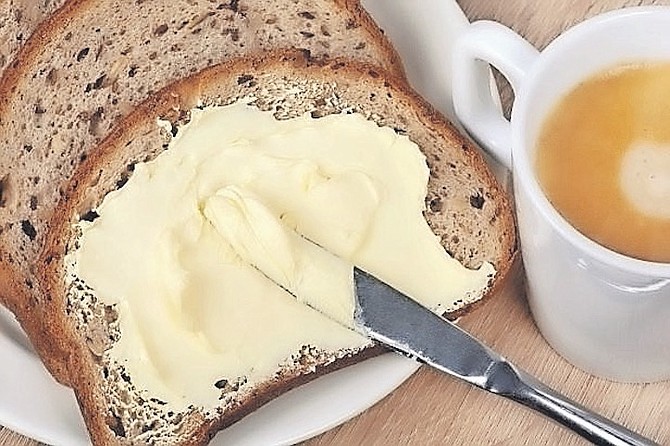By Dr Selima Hauber
of One Eleuthera Foundation
IF corn were to be wiped from the face of the earth by a maniacal pathogen, we Bahamians would be lost for breakfast. On just about every restaurant menu throughout the archipelago, one can find “boiled fish”, “stewed fish”, “corned beef”, “tuna”, and “steamed sausage”, all traditionally served with grits. My taste buds go crazy for buttery grits paired with boiled fish or tuna salad, accentuated by the flavorful combination of lime, goat pepper and savory onions. Nothing feels more like a warm hug for the tummy, than steamy grits topped with golden pools of melted butter.
Now if grits are not your thing, surely you would slather the golden goodness on hot Johnny Cake. Before we continue this mouth-watering discourse, I need to make sure you are thinking of what I am actually talking about. I do mean butter. You know, the product of churned cow’s milk. Just like disposal diapers, dishwashing liquid and laundry detergent which we culturally assign the popular brand name as their moniker, we tend to refer to all butter-like substances as “butter”. For most of my childhood, butter was the pale-yellow, rectangular block that was wrapped in paper; or the large tub-version that was spreadable. Even though these products were labeled as “margarine” or “vegetable oil spread”, in my mind, it was “butter”. I did not really appreciate the difference until adulthood.
Margarine was invented in France in the late nineteenth century in response to Napoleon III’s challenge to provide a cheap butter substitute for his troops and peasant workers during the Franco-Prussian war. A French chemist rose to the challenge and developed the first “margarine” by churning beef tallow with milk. Margarine experienced a number of iterations over its lifetime. In the early 1900s, the limited availability of beef tallow resulted in an innovation of using vegetable oils after the process of hydrogenation was discovered. Hydrogenation allowed seed-expressed oils that are liquid at room temperature, to solidify and resemble the original margarine. Margarine is naturally white in colour, so adding dyes so that it more closely resembled butter became a practice that was banned in some countries. Clever manufacturers got around this restriction by selling a separate packet of food colouring with the white margarine that the consumer would then knead into the spread.
The process of hydrogenation was a boon for the food science industry. Making vegetable oils solid at room temperature, more shelf stable and with a pleasant taste and texture made them the perfect, cheap replacement for butter in commercial baked goods, snack foods and fast foods. Enter the war on fat in the 80s to curb the tide of heart disease in America, vegetable shortening, and spreads were touted as the “healthier” alternative to butter and animal fats. What we did not know at the time, was that the process of hydrogenation produced dangerous trans fatty acids. Consuming trans fats increases the harmful cholesterol (LDL) and decreases the good cholesterol (HDL). This increases your risks of heart disease and stroke. Consuming trans fats also increases one’s risks of developing Type 2 diabetes. Research in the 1990s which unveiled the harmful effects of artificial trans fats in our diet led to the US Food and Drug Administration stating in 2015 that partially hydrogenated oils (the major source of trans fats) could no longer be generally recognised as safe (GRAS). Fast forward to 2020, and the use of partially hydrogenated oils in food products is “banned” in the US, even though they can legally contain half a gram of trans fats per serving.
My personal study over the last three years into how food affects our health has led me to turn to nut and seed “milks”. I wanted to protect my children from premature puberty and to control the growth of my own uterine fibroids. I have to say, choosing soy milk was the easy part. Total elimination of dairy products like butter and cheese, however, is near impossible. I really do enjoy butter, especially now that I have perfected sourdough bread-making. I have made peace with butter because the alternative is far too harmful. To reduce consumption of trans fats, avoid packaged foods with “partially hydrogenated oil” in the list of ingredients. Avoid using seed or vegetable oils for cooking. Heating soybean, vegetable, corn or canola oils also produces trans fats. Healthier choices for cooking are olive oil, avocado oil and coconut oil.
Now back to our beloved Boiled Fish and grits, with Johnny Cake. Knowing what I know now, when ordering tuna-and-grits at a breakfast spot, I ask if it is served with butter or margarine. I don’t take for granted that what they claim is “butter”, is really “butter”. Butter and margarine are not created equal, and I will not gamble my health on the differences.
• Dr Selima Hauber, PhD, is the agricultural education and outreach officer at OEF and CTI. Established in 2012, the One Eleuthera Foundation (OEF) is a non-profit organisation located in Rock Sound, Eleuthera. For more information, visit www.oneeleuthera.org or email info@oneeleuthera. org. The Centre for Training and Innovation (CTI) is the first and only postsecondary, non-profit education and training institution and social enterprise on Eleuthera. CTI operates a student training campus in Rock Sound, Eleuthera, with a 16-room training hotel, restaurant and farm. For more information about CTI’s programmes, email: info@oneeleuthera.org.








Comments
Use the comment form below to begin a discussion about this content.
Sign in to comment
Or login with:
OpenID